Welcome to the latest selection of recent top articles in the physica status solidi journals. Get a glimpse of our publication spectrum and visit our pages by clicking on any of the DOI links below.
Ferroelectricity from iron valence ordering in rare earth ferrites? [Review@RRL]
Manuel Angst
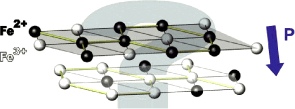 Magnetoelectric multiferroics have a large applications potential for example in information technology, with the main challenge being the identification of suitable materials and mechanisms of ferroelectricity. “Ferroelectricity originating from charge ordering” is a particularly intriguing mechanism for obtaining multiferroics, but experimentally indicated examples are exceedingly rare. In this article, recent research on rare earth ferrites, the prototypical “proof of principle” example materials, is reviewed.
Magnetoelectric multiferroics have a large applications potential for example in information technology, with the main challenge being the identification of suitable materials and mechanisms of ferroelectricity. “Ferroelectricity originating from charge ordering” is a particularly intriguing mechanism for obtaining multiferroics, but experimentally indicated examples are exceedingly rare. In this article, recent research on rare earth ferrites, the prototypical “proof of principle” example materials, is reviewed.
Phys. Status Solidi RRL (2013) DOI 10.1002/pssr.201307103
Photoconductivity as loss mechanism in organic solar cells [Rapid Research Letter]
Wolfgang Tress, Karl Leo, and Moritz Riede
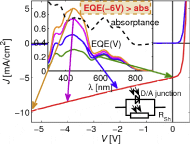 The reverse current of solar cells with acceptor C60 shows a linear current–voltage relation under illumination. This current is due to photoconductivity in the pure layers, generating a photoshunt and internal quantum efficiencies larger than unity for negative bias. The photoshunt represents a loss path reducing the fill factor.
The reverse current of solar cells with acceptor C60 shows a linear current–voltage relation under illumination. This current is due to photoconductivity in the pure layers, generating a photoshunt and internal quantum efficiencies larger than unity for negative bias. The photoshunt represents a loss path reducing the fill factor.
Phys. Status Solidi RRL (2013) DOI 10.1002/pssr.20137039
Rapid thermal annealing of FePt thin films [Feature Article]
Manfred Albrecht and Christoph Brombacher
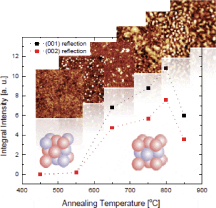 This Feature Article presents the state-of-the-art concerning the formation of chemically L10 ordered FePt thin films induced by rapid thermal annealing (RTA). The influence of the annealing temperature, annealing time, and film thickness on the ordering transformation and (001) texture evolution of the FePt thin films is studied and the possible mechanisms for the formation are discussed. In this regard, RTA processing is a potentially interesting technology for the preparation of FePt thin films with strong perpendicular magnetic anisotropy, important for future magnetic storage devices.
This Feature Article presents the state-of-the-art concerning the formation of chemically L10 ordered FePt thin films induced by rapid thermal annealing (RTA). The influence of the annealing temperature, annealing time, and film thickness on the ordering transformation and (001) texture evolution of the FePt thin films is studied and the possible mechanisms for the formation are discussed. In this regard, RTA processing is a potentially interesting technology for the preparation of FePt thin films with strong perpendicular magnetic anisotropy, important for future magnetic storage devices.
Phys. Status Solidi A (2013) DOI 10.1002/pssa.201228718
Heterogeneous integration of hexagonal boron nitride on bilayer quasi-free-standing epitaxial graphene and its impact on electrical transport properties [Advanced Materials Physics]
M. J. Hollander, A. Agrawal, M. S. Bresnehan, M. LaBella, K. A. Trumbull, R. Cavalero, D. W. Snyder, S. Datta, and J. A. Robinson
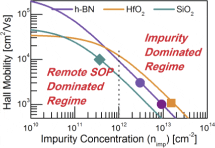 The effects of hexagonal boron nitride on electrical transport properties of bilayer quasi-free-standing epitaxial graphene are investigated and compared to the high-k dielectric HfO2. Modeling is used to explain the effect of substrate step-edge density and charged impurities introduced by the dielectric overlayers on transport properties, showing that reducing step-edges and use of boron nitride can lead to >5× increase in mobility.
The effects of hexagonal boron nitride on electrical transport properties of bilayer quasi-free-standing epitaxial graphene are investigated and compared to the high-k dielectric HfO2. Modeling is used to explain the effect of substrate step-edge density and charged impurities introduced by the dielectric overlayers on transport properties, showing that reducing step-edges and use of boron nitride can lead to >5× increase in mobility.
Phys. Status Solidi A (2013) DOI 10.1002/pssa.201228683
A review of the manufacture, mechanical properties and potential applications of auxetic foams [Feature Article]
Richard Critchley, Ilaria Corni, Julian A. Wharton, Frank C. Walsh, Robert J. K. Wood, and Keith R. Stokes
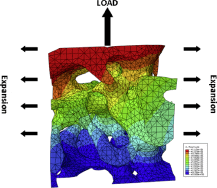 In this Feature Article, Critchley et al. introduce the expanding field of auxetic materials and critically review the literature with a primary focus on auxetic foams. Particular attention is given to the fabrication methodologies, the influence played by the fabrication parameters, the microstructural models (both two- and three-dimensional), the mechanical properties and the potential applications of these materials.
In this Feature Article, Critchley et al. introduce the expanding field of auxetic materials and critically review the literature with a primary focus on auxetic foams. Particular attention is given to the fabrication methodologies, the influence played by the fabrication parameters, the microstructural models (both two- and three-dimensional), the mechanical properties and the potential applications of these materials.
Phys. Status Solidi B (2013) DOI 10.1002/pssb.201248550
Metal-supported catalysts encapsulated in mesoporous solids: Challenges and opportunities of a model concept [Feature Article]
W. Grünert, H. Gies, M. Muhler, S. Polarz, C. W. Lehmann, D. Großmann, M. van den Berg, O. P. Tkachenko, A. De Toni, I. Sinev, M. Bandyopadhyay, V. Narkhede, A. Dreier, K. V. Klementiev, A. Birkner, and E. Löffler
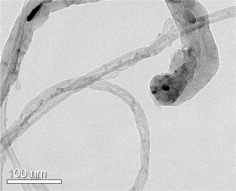 An overview of work with model systems designed to study the metal–support interactions in heterogeneous catalysts is given. In these models, metal and support are both miniaturized by introduction as guests into a mesoporous host. The use of such models is demonstrated with Au–TiO2 clusters encaged in MCM-48, and Cu–ZnO clusters encapsulated in siliceous mesopore systems and in carbon nanotubes. The models promise a better opportunity to track changes in the support component during catalyst activation and catalysis, including the action of poisons that may at first be trapped on the support surface.
An overview of work with model systems designed to study the metal–support interactions in heterogeneous catalysts is given. In these models, metal and support are both miniaturized by introduction as guests into a mesoporous host. The use of such models is demonstrated with Au–TiO2 clusters encaged in MCM-48, and Cu–ZnO clusters encapsulated in siliceous mesopore systems and in carbon nanotubes. The models promise a better opportunity to track changes in the support component during catalyst activation and catalysis, including the action of poisons that may at first be trapped on the support surface.
Phys. Status Solidi B (2013) DOI 10.1002/pssb.201248454
















